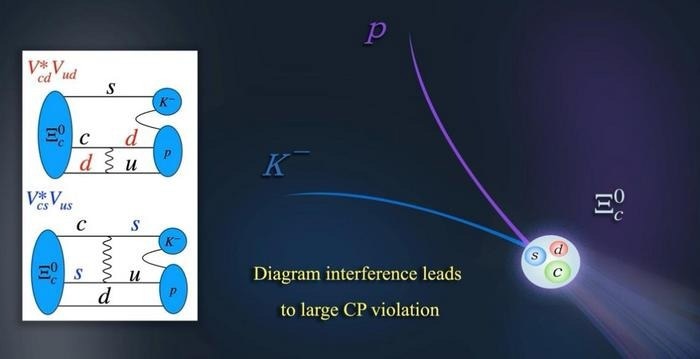Professor Xiao-Gang He and Dr. Chia-Wei Liu of Shanghai Jiao Tong University's Tsung-Dao Lee Institute (TDLI) used the framework of final-state re-scattering in conjunction with SU(3) flavor symmetry theory. Compared to earlier predictions, their methodology predicts far greater CP violation consequences in charmed baryon decays. The study was published in the journal Science Advances. The study was published in Science Bulletin.

The research team discovered that the decay could produce CP violation effects one order of magnitude larger than previously predicted, as illustrated by the two quark diagrams on the left. Image Credit: Science China Press
For a long time, the scientific world was perplexed by matter's supremacy over antimatter in the cosmos. CP violation is seen as a critical component in understanding this cosmic riddle. As Nobel laureate Tsung-Dao Lee stated, “Symmetry reveals the beauty of the universe, while asymmetry generates its substance.”
Previous studies have found unexpectedly substantial CP violation effects in charming meson decays, while experiments in charmed baryon decays have not yielded conclusive results.
The study emphasizes the importance of final-state re-scattering in the CP violation phenomenon. This method promotes efficient secondary interactions between particles, resulting in the strong phases required for CP violation. The projected matter-antimatter imbalance in charmed baryon decays might be as high as one thousandth, greatly beyond previous theoretical estimates.
TDLI, founded in Shanghai in 2017, is dedicated to solving nature's secrets.
The research on charm CP violation opens new pathways for experimental exploration and provides deeper insights into the fundamental mechanisms underlying the universe’s matter-antimatter asymmetry. It offers important opportunities for further tests of the Standard Model and potential discoveries of new physics.
Xiao-Gang He, Professor and Head, Particle and Nuclear Physics Division, Shanghai Jiao Tong University
The study findings have intriguing implications for experimental verification. Currently, experiments like as BESIII, LHCb, and Belle II can detect specific particles. China’s forthcoming Super Tau-Charm Facility (STCF) is intended to greatly improve sensitivity, providing continuous assistance for frontier investigation by the physics community.
Journal Reference:
He, X. and Liu, C.-W. (2025) Large CP violation in charmed baryon decays. Science Bulletin. doi.org/10.1016/j.scib.2025.05.045.